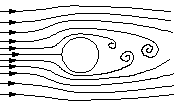Streamlines and Streamtubes
Streamlines and Streamtubes
A streamline is a line that is
tangential to the instantaneous velocity direction (velocity is a vector, and
it has a magnitude and a direction). To visualize this in a flow, we
could imagine the motion of a small marked element of fluid. For example, we could mark a
drop of water with fluorescent dye and illuminate it using a laser so
that it fluoresces. If we took a short exposure photograph as the drop moves
according to the local velocity field (where the exposure needs to be short compared to the
time it takes for the velocity to change appreciably), we would see a short streak, with a
length
V \Delta t, and with a direction tangential to the instantaneous velocity direction. If we
mark many drops of water in this way, the streamlines in the
flow will become visible. Since the velocity at any point in the flow has a single value
(the flow cannot go in more than one direction at the same time), streamlines cannot
cross. except at points where the velocity
magnitude is zero, such as at a stagnation point.
There are other ways to make the flow visible. For example, we can trace out the path
followed by our fluorescent drop using a long-exposure photograph. This line is called a
pathline, and it is similar to what you see when you take a long-exposure photograph
of car lights on a freeway at night. It is possible for pathlines to cross, as you can
imagine from the freeway analogy: as a car changes lanes, the pathline traced out by its
lights might cross another pathline traced out by an adjoining vehicle at a different
time.
Another way to visualize flow patterns is by streaklines. A streakline is the
line traced out by all the particles that passed through a particular point at some earlier
time. For instance, if we issued fluorescent dye continuously from a fixed point, the dye
makes up a streakline as it passes downstream. To continue the freeway analogy, it is the
line made up of the lights on all the vehicles that passed through the same toll booth.
If they all follow the same path (a steady flow), a single line results, but if they follow
different paths (unsteady flow), it is possible for the line to cross over itself.
In
unsteady flow, streamlines, pathlines and streaklines are all different, but in steady flow, streamlines, pathlines
and streaklines are identical.
Streamtubes
Imagine a set of streamlines starting
at points that form a closed loop (figure 18).
 |
|
Figure 18. Streamlines forming a streamtube.
|
These streamlines form a tube that is impermeable since the walls of the tube are made up
of streamlines, and there can be no flow normal to a streamline (by definition). This tube
is called a streamtube. From mass conservation, we see that for a steady,
one-dimensional flow, the mass-flow rate is constant along a streamtube.
In a constant density flow, therefore, the cross-sectional area of the streamtube gives
information on the local velocity.
As an example, consider steady, constant density flow
over a cylinder, where the cylinder axis is normal to the direction of the incoming flow
(figure 19).
 |
|
Figure 19. Flow over a cylinder.
|
Far upstream of the cylinder, the flow is uniform in all
directions (we could call this a zero-dimensional flow). The flow near the cylinder varies
in the streamwise and
normal directions but not in the spanwise direction. So the flow near
the cylinder is two-dimensional.
In this region the streamlines come closer together, and the area between
them decreases. Since the density is constant, the velocity must increase according to the
principle of mass conservation. For constant density flow, wherever the area between
streamlines decreases, the velocity increases. This is exactly similar to what happens
with constant-density flow through a duct or a pipe --- if the area decreases, the velocity
increases so that the volume flow rate is maintained constant (volume flow rate out must
equal volume flow rate in by continuity). At a reasonable speed for a reasonably sized cylinder (more
precisely, at Reynolds numbers that are not too small), the maximum flow velocity in the
region where the streamtubes take their minimum area is about 1.74 times the velocity in the
far-field.
As the flow passes over the shoulder of the cylinder, it separates (we saw a similar
separation phenomenon in the diffuser flow shown in figure 10). Large eddying
motions form in the wake of the cylinder, and the wake flow is unsteady and
three-dimensional. Streamlines become very difficult to visualize and interpret in this
region.
Return to Aerodynamics of Bicycles Introduction.